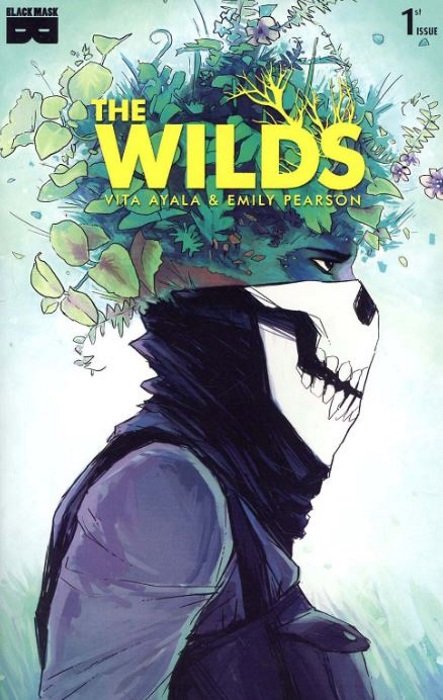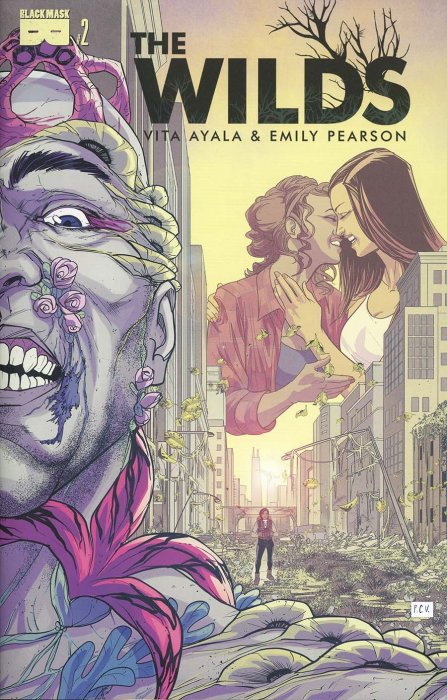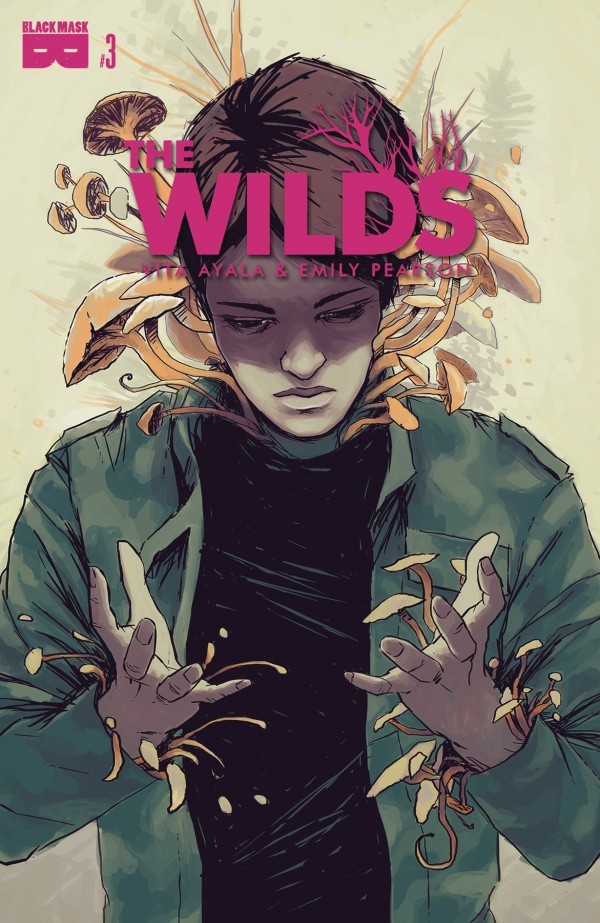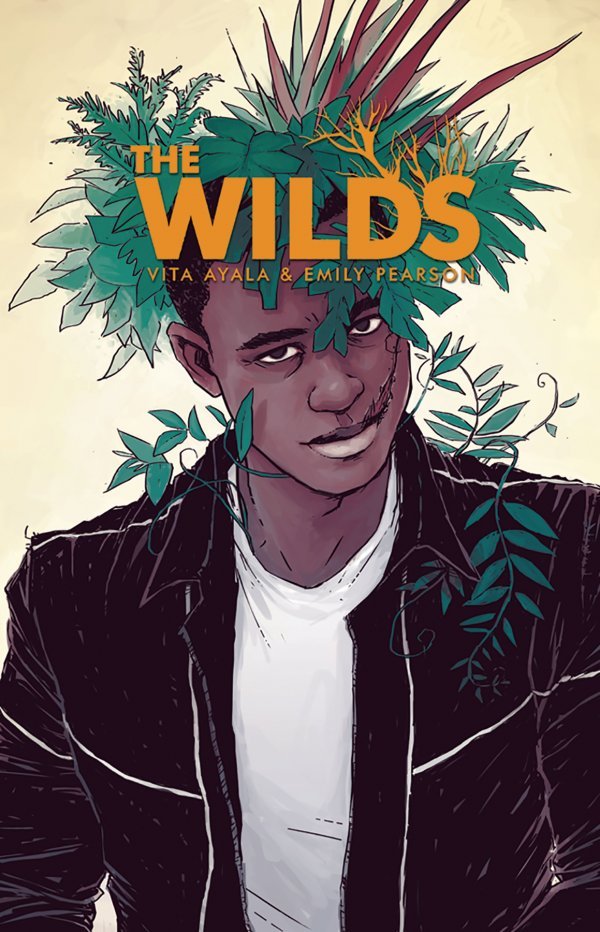Post-apocalyptic stories have long been used to make commentary on the world about us and the mechanics of society, but few have used the genre to examine the idea of exploiting marginalized populations or even the concept behind self-care. However, writer Vita Ayala and artist Emily Pearson have picked up on those themes to create a gripping, sometimes-scary, always thoughtful tale of preservation and survival in their new comic series The Wilds from Black Mask Studios.
In The Wilds, the United States—and maybe the world—has been decimated by a virus that turns people into “Abominations,” forcing the remnants of society to come together in walled-off enclaves to survive. The book centers on Daisy Walker, a Runner in this newly organized society who acts as a courier between settlements, delivering messages, supplies, and the occasional person. However, more widely, the book explores how people cope with and change with adversity and an upheaval of all that they’ve always known.
Vita Ayala, Emily Pearson, and the book’s editor Danny Lore spoke with me recently about the idea behind The Wilds, Daisy’s motivations, and how the series’ characters deal with a “new normal.”
FreakSugar: For folks who are considering picking up the book, what is the conceit of The Wilds?
Vita Ayala: The Wilds is a post-apocalyptic book that marries the idea of zombies (and thematically what they entail) and nature. A virus has swept through America (and possibly the world) and what remains of humanity has had to ban together to form walled-off settlements to survive. We follow a survivor, Daisy Walker, who lives and works for a specialized settlement called The Compound, which is a mix of the USPS and the black market. Daisy is a Runner; Runners are couriers, they go into the world outside the walls to ferry cargo (supplies, messages, and sometimes people) between settlements, and also find salvage among the ruins left behind.
Thematically, The Wilds is about exploitation of marginalized populations (especially PoC, and DOUBLE especially WoC), who are expected to do tremendous amounts of physical and emotional labor (often to their own detriment) and are given nothing in return. It is about finding a balance between doing good for others and respecting and caring for oneself, in a time when things look especially dire.
Danny Lore: The Wilds is a book about really amazing, strong people learning that sometimes you don’t have to be strong for everyone else. That you’ve got to save something for yourself and your loved ones. Otherwise, you’ve gotta deal with flower zombies, and that’s a LOT! If someone is considering picking up the book, I’d say it is for the reader that appreciates found family, a dose of action, and learning to protect yourself.
FS: Just from reading the first issue, the world and the inhabitants of the world of The Wilds feels so fleshed-out and lived-in. How long has the idea for the book been gestating?
VA: For me, the spine of the story has been around since I was in college – at least 7 years now. The themes, and most of the characters, have been with me in some form or another for that long. BUT, the plot and the fleshed out metaphors, some of the characters that are now vital, and all of the design and art came out of my collaboration with Emily. She is my co-creator and a godsend.
Emily Pearson: I came into the process roughly a year ago (late 2016-early 2017). There was a long period of time where we have the pitch ready, and we just needed to wait for a good chance to pitch it. I think the both of us had a while to really think about the world and how we wanted to show it.
FS: Daisy is our main through character in the first issue. What can you tell us about her and her motivations in the world we find ourselves in?
VA: A very important part of Daisy’s character is that she has always wanted to help people. She was a medical student before the plague came, on her way to becoming a doctor, and even after that wasn’t an option, she feels a lot of responsibility to others. She truly believes that if she stops being a Runner, people will suffer, people will DIE, and that thought drives her. She has had to develop a tough outer skin, but she is very sensitive and caring.
DL: Daisy is probably one of the most relatable characters to me, in terms of her motivations–even more so than Heather (who I could squeal about for ages). She’s between a rock and a hard place: the horrors of the post-virus apocalypse, and the restrictions put on her because she ‘has’ to be a hero. Being a hero–a runner, a servant of the greater good–has been defined for her. Her motives are the same as they were before the plague, it’s now a question of what that means in this new world.
EP: Alongside with what Vita and Danny mentioned, I think it’s gonna be a treat to really see Daisy grow as the story goes on. As she learns more about the world and problems around her, she changes and develops as a character.
FS: The look of the book is both gorgeous and haunting at the same time. How did you decide on what you wanted the look of The Wilds to be?
VA: I will leave this up to Emily mostly, because she is really the driving force behind this. I will say though, that Em and I have been almost psychically connected about this. She ALWAYS seemed to know during development what I was thinking about, design and tone wise, and once we were onto actually creating the book, I have been able to really just step back and let her do what she feels is right. I trust her completely! I think I had the biggest hand in the initial face references for the main characters, but that was it. [laughs]
DL: I also have to give the strongest of shout outs to Marissa Louise, our colorist. The combination of her and Emily on this book really makes it on a level I can’t really describe without going full fanboy. That said, it’s 100% deserved. The haunting use of space from Emily, the rich colors that Marissa brings–they work in tandem to make The Wilds stand out amongst the grayer, less-vibrant zombie apocalypse norm.
EP: Pinterest actually helped us a lot. Before I got the script, I had a slightly different look in mind, which was a little more horror-like and almost a witchy kind of vibe to it. We started pinning pictures of nature and apocalyptic landscapes, and through that I think it was really clear what we wanted the world to look like. I live in Northern California so there’s tons of beautiful nature around me. I started taking pictures of the trees on the highway, and the scattered nature that appears everywhere. Since a lot of nature you see in the Wilds is when Daisy’s driving, I wanted to get that feeling of looking at a forest or hillside from your car. Vita puts forwards a lot of great ideas for scenes, and Marissa does an amazing job with the colors, so I had a lot of help.
FS: Following up on that, the markings on the Abominations are represented by feathers and flowers? It’s beautiful and like nothing we’ve seen in these types of tales before. What was the reason behind that stylistic choice?
VA: Again, I will leave this mostly to Emily, but I will say that one of the things that we wanted very much to do with the book is to present something that was equally beautiful as it was terrifying. Also we wanted to link the “outside” danger of the book as much to nature as we possibly could.
EP: For the book, I think we wanted something that would be interesting to look at as well. In a lot of zombie stories, the infected are defined by the rotting flesh and gore. For this story the bodies aren’t deteriorating, the virus is keeping the body healthy, but also growing plants from the inside. I feel like an infection that’s colorful and beautiful really compliments the world of The Wilds better.
FS: One part that grabbed me early on in the issue is how so many people who heard about the sickness that killed or transformed those infected were, at first, almost inured to the news.
VA: I was thinking about the Ebola scare that happened a few years ago a lot when I was writing that. I was thinking both how sensationalist it was, but also how poorly informed. That was the feel I wanted to give there.
FS: Eventually, we see the “new normal” after what we know of civilization falls apart. Are you going to be exploring that new normal further in the series?
VA: I wanted to give a feel for the new world in a way that was organic to the story. There is a lot that couldn’t fit into the first issue, that we do put into following issues. There is also a larger world HINTED at in the story arc that isn’t fully realized, but in a way that makes sense to this story. There is room for more issues/stories, but these will (hopefully) leave people satisfied with what they have read!
DL: One of the most exciting parts for me as an editor is getting to see the world that’s being hinted throughout the book, and the discussions that Emily and Vita have about it. They really this great world that’s only just starting to blossom (I wanted at least ONE floral pun, so there) in the first issue of The Wilds. My favorite way that you see that is in some of the “Best Runs” shorts, where you see the Runners share some of their past adventures with one another. It’s really cool though, the way Vita thinks about this tale–the story of this world doesn’t stop at the compound. There’s so much more!
EP: Each issue really explores a new part of the world. In the first issue, we got to see a bit of the River Bend settlement, and the Compound. Along with exploring settlements, you’ll see a lot of abandoned or forgotten places.
FS: While being its own unique creation, The Wilds shares DNA with other post-apocalyptic tales from the past. Are there any particular influences that guide your telling of the story you’ve set out to create?
VA: Personally, I looked a lot to franchises like Mad Max, Resident Evil, Last of Us, The Area X/Southern Reach trilogy, among others, to inform some of the story telling on my part. The post-apocalyptic genre is one of my favorites, and I felt that I didn’t have to reinvent the wheel here, but that I DID want to do something new/fresh, and from our team’s perspective. Rarely do we get to see these stories from the point of view of brown and queer people, which informs a lot of the story for us here.
EP: I got a lot of inspiration from what Vita mentioned, but also books and games like The Road, Into the Forest, Fallout, Borderlands. As much as I love the post-apocalyptic stories that have been told, a huge part of inspiration for this story was wanting more.
FS: Is there anything you can tease about what to expect in the series going forward?
VA: Just that there will be MORE of everything seen in the first issue. More action, more emotional development, more Runners (we love them so much), more flower zombies, and more commentary on society woven into the fabric of the book in a way that is (hopefully) smooth and relevant. We have a smaller set of stories (4 pages at the end of each book, called the Best Runs) that will highlight characters in a dynamic way, and each Best Run also features a guest artist, which is really fun I think.
DL: A lot of hard choices and badass action! The complexities of their world are only starting to be revealed. The characters you’re starting to love have enormous burdens on their shoulders, and we’ll get to see how they handle them, and what happens when they become too big to bear.
EP: Definitely more Abominations and more Runners! There are three Runners that haven’t been introduced yet, which I think a lot of readers are going to enjoy getting to know.
The Wilds #3 goes on sale Wednesday, May 30th, from Black Mask Studios.
From the official issue description:
Awakening in captivity, Heather realizes that she is at the mercy of monsters worse than the Abominations. She uncovers horrifying secrets in the dark underbelly of Medical Central, which could shatter what is left of human society. Out in the wild, Daisy has traveled to The Pit to say a final goodby to a fellow Runner, but finds herself besieged by a horde of Abominations the likes of which have never been seen…





